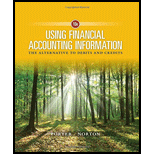
Using Financial Accounting Information
10th Edition
ISBN: 9781337276337
Author: Porter, Gary A.
Publisher: Cengage Learning,
expand_more
expand_more
format_list_bulleted
Question
Chapter 4, Problem 4.11.1E
To determine
Introduction: Accrual concept is followed by the organization to record the transactions. The accrual basis of accounting states that an organization should record the expenses and revenues when these are incurred or earned and not when these are paid or received.
To identify & analyze: The transaction to record the sale of yearly subscription and the transaction.
Expert Solution & Answer
Trending nowThis is a popular solution!

Students have asked these similar questions
How much should be recorded as goodwill??
Not use ai solution please and accounting question
On January 1, 2025, Fisher Company makes the two following acquisitions.
1.
2.
Purchases land having a fair market value of $800,000 by issuing a 5-year, zero-interest-bearing promissory note in the face
amount of $1,175,468.
Purchases equipment by issuing a 4%, 8-year promissory note having a maturity value of $350,000 (Interest payable annually
on January 1).
The company has to pay 8% interest for funds from its bank.
(a)
(b)
Record the two journal entries that should be recorded by Fisher Company for the two purchases on January 1, 2025.
Record the interest at the end of the first year on both notes using the effective-interest method.
(Round present value factor calculations to 5 decimal places, e.g. 1.25124 and the final answer to O decimal place, e.g.
58,971. If no entry is required, select "No Entry" for the account titles and enter O for the amounts. Credit account titles are
automatically indented when the amount is entered. Do not indent manually. List all debit entries…
Chapter 4 Solutions
Using Financial Accounting Information
Ch. 4 - Revenue Recognition The highway department...Ch. 4 - Prob. 4.2.1ECh. 4 - Prob. 4.2.2ECh. 4 - Prob. 4.2.3ECh. 4 - Prob. 4.3ECh. 4 - Prob. 4.4ECh. 4 - Prob. 4.5ECh. 4 - Prob. 4.6.1ECh. 4 - Prob. 4.6.2ECh. 4 - Prob. 4.6.3E
Ch. 4 - Prob. 4.6.4ECh. 4 - Prob. 4.7.1ECh. 4 - Prob. 4.7.2ECh. 4 - Prob. 4.8.1ECh. 4 - Prob. 4.8.2ECh. 4 - Prob. 4.8.3ECh. 4 - Prob. 4.8.4ECh. 4 - Prob. 4.8.5ECh. 4 - Prob. 4.9.1ECh. 4 - Working Backward: Depreciation Polk Corp....Ch. 4 - Prob. 4.10.1ECh. 4 - Prob. 4.10.2ECh. 4 - Prob. 4.10.3ECh. 4 - Prob. 4.10.4ECh. 4 - Prob. 4.11.1ECh. 4 - Prob. 4.11.2ECh. 4 - Prob. 4.11.3ECh. 4 - Prob. 4.12.1ECh. 4 - Prob. 4.12.2ECh. 4 - Prob. 4.12.3ECh. 4 - Prob. 4.13.1ECh. 4 - Prob. 4.13.2ECh. 4 - Prob. 4.13.3ECh. 4 - Prob. 4.14ECh. 4 - Prob. 4.15.1ECh. 4 - Prob. 4.15.2ECh. 4 - Prob. 4.15.3ECh. 4 - Prob. 4.15.4ECh. 4 - Prob. 4.15.5ECh. 4 - Prob. 4.16.1ECh. 4 - Prob. 4.16.2ECh. 4 - Prob. 4.16.3ECh. 4 - Prob. 4.17.1ECh. 4 - Prob. 4.17.2ECh. 4 - Prob. 4.18.1ECh. 4 - Prob. 4.18.2ECh. 4 - Prob. 4.18.3ECh. 4 - Prob. 4.19.1ECh. 4 - Prob. 4.19.2ECh. 4 - Prob. 4.20.1ECh. 4 - Prob. 4.20.2ECh. 4 - Prob. 4.20.3ECh. 4 - Prob. 4.21.1ECh. 4 - Prob. 4.21.2ECh. 4 - Prob. 4.22ECh. 4 - The Effect of Ignoring Adjustments on Net Income...Ch. 4 - Prob. 4.24ECh. 4 - Prob. 4.25ECh. 4 - Prob. 4.26.1MCECh. 4 - Prob. 4.26.2MCECh. 4 - Depreciation Expense During 2017, Carter Company...Ch. 4 - Depreciation Expense During 2017, Carter Company...Ch. 4 - Prob. 4.28.1MCECh. 4 - Prob. 4.28.2MCECh. 4 - Prob. 4.1.1PCh. 4 - Prob. 4.1.2PCh. 4 - Prob. 4.2.1PCh. 4 - Prob. 4.2.2PCh. 4 - Prob. 4.3PCh. 4 - Prob. 4.4.1PCh. 4 - Prob. 4.4.2PCh. 4 - Prob. 4.5.1PCh. 4 - Prob. 4.5.2PCh. 4 - Prob. 4.5.3PCh. 4 - Prob. 4.6.1PCh. 4 - Prob. 4.6.2PCh. 4 - Prob. 4.6.3PCh. 4 - Prob. 4.6.4PCh. 4 - Prob. 4.6.5PCh. 4 - Prob. 4.6.6PCh. 4 - Prob. 4.7.1PCh. 4 - Prob. 4.7.2PCh. 4 - Prob. 4.8MCPCh. 4 - Prob. 4.9.1MCPCh. 4 - Prob. 4.9.2MCPCh. 4 - Monthly Transactions, Adjustments, and Financial...Ch. 4 - Prob. 4.9.4MCPCh. 4 - Prob. 4.9.5MCPCh. 4 - Prob. 4.1.1AAPCh. 4 - Prob. 4.1.2AAPCh. 4 - Prob. 4.2.1AAPCh. 4 - Prob. 4.2.2AAPCh. 4 - Prob. 4.3AAPCh. 4 - Use of Account Balances as a Basis for Annual...Ch. 4 - Prob. 4.4.2AAPCh. 4 - Prob. 4.5.1AAPCh. 4 - Prob. 4.5.2AAPCh. 4 - Prob. 4.6.1AAPCh. 4 - Prob. 4.6.2AAPCh. 4 - Prob. 4.6.3AAPCh. 4 - Prob. 4.6.4AAPCh. 4 - Prob. 4.6.5AAPCh. 4 - Prob. 4.6.6AAPCh. 4 - Prob. 4.7.1AAPCh. 4 - Prob. 4.7.2AAPCh. 4 - Prob. 4.8AAMCPCh. 4 - Prob. 4.9.1AAMCPCh. 4 - Prob. 4.9.2AAMCPCh. 4 - Prob. 4.9.3AAMCPCh. 4 - Prob. 4.9.4AAMCP
Knowledge Booster
Learn more about
Need a deep-dive on the concept behind this application? Look no further. Learn more about this topic, accounting and related others by exploring similar questions and additional content below.Similar questions
- Question Accounting-Cash conversion cycle: Pem Corp. has an inventory period of 22.6 days, an accounts payable period of 37.7 days, and an accounts receivable period of 31.9 days. What is the company's cash cycle? Need answerarrow_forwardQuick answer of this accountingarrow_forwardAccounting problemarrow_forward
arrow_back_ios
SEE MORE QUESTIONS
arrow_forward_ios
Recommended textbooks for you
 Financial Accounting: The Impact on Decision Make...AccountingISBN:9781305654174Author:Gary A. Porter, Curtis L. NortonPublisher:Cengage LearningPrinciples of Accounting Volume 1AccountingISBN:9781947172685Author:OpenStaxPublisher:OpenStax College
Financial Accounting: The Impact on Decision Make...AccountingISBN:9781305654174Author:Gary A. Porter, Curtis L. NortonPublisher:Cengage LearningPrinciples of Accounting Volume 1AccountingISBN:9781947172685Author:OpenStaxPublisher:OpenStax College Intermediate Accounting: Reporting And AnalysisAccountingISBN:9781337788281Author:James M. Wahlen, Jefferson P. Jones, Donald PagachPublisher:Cengage Learning
Intermediate Accounting: Reporting And AnalysisAccountingISBN:9781337788281Author:James M. Wahlen, Jefferson P. Jones, Donald PagachPublisher:Cengage Learning- Principles of Accounting Volume 2AccountingISBN:9781947172609Author:OpenStaxPublisher:OpenStax College

Financial Accounting: The Impact on Decision Make...
Accounting
ISBN:9781305654174
Author:Gary A. Porter, Curtis L. Norton
Publisher:Cengage Learning

Principles of Accounting Volume 1
Accounting
ISBN:9781947172685
Author:OpenStax
Publisher:OpenStax College

Intermediate Accounting: Reporting And Analysis
Accounting
ISBN:9781337788281
Author:James M. Wahlen, Jefferson P. Jones, Donald Pagach
Publisher:Cengage Learning


Principles of Accounting Volume 2
Accounting
ISBN:9781947172609
Author:OpenStax
Publisher:OpenStax College
7.2 Ch 7: Notes Payable and Interest, Revenue recognition explained; Author: Accounting Prof - making it easy, The finance storyteller;https://www.youtube.com/watch?v=wMC3wCdPnRg;License: Standard YouTube License, CC-BY